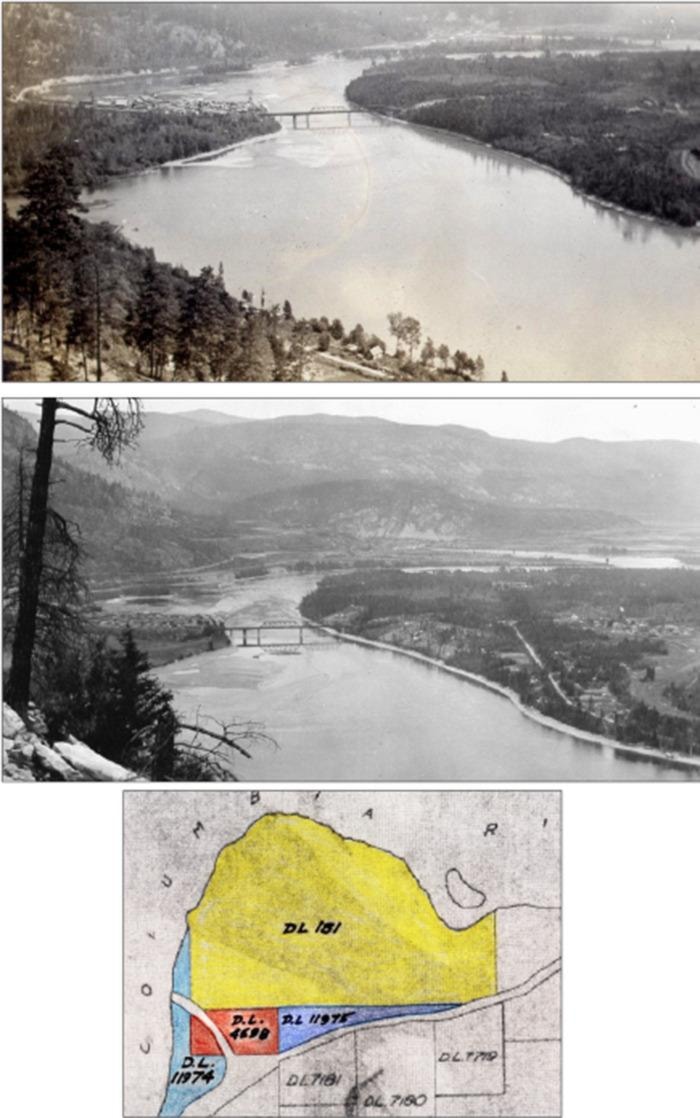After Edward Mahon bought Lot 181 from Albert McCleary in 1891 he waited for an opportunity to develop it into a townsite to be named after his family estate in County Galway.
That opportunity presented itself in the person of Augustus F. Heinze who in 1897 brought his Columbia and Western Railway through Castlegar, ending the track at Robson West.
Heinze became a partner in the prospective townsite by contributing 12 blocks (the Heinze Subdivision) to Edward’s 34 blocks, which had been subdivided from the northernmost portion of Lot 181 (the Mahon Subdivision). Heinze’s contribution was derived from Lot 4598, a vast railway grant he had secured in 1896: it extended from Trail to Castlegar and eastward well into the Bonnington Range.
Most likely the Montana Copper King had no intention of developing Edward’s townsite, as he was simultaneously bargaining with the CPR. Four months after the townsite agreement was signed Heinze sold out to the railway monopoly and headed south to continue with the Copper War in Butte.
Edward’s new partner had no interest in developing Castlegar Junction beyond the bare necessities required for the railway operations, which were being accelerated to beat the Americans to the mineral wealth of the Boundary country.
To forestall development in Lot 181, half of all the townsite blocks were deeded over to the Columbia and Western Railway (probably in Edward’s original agreement with Heinze); thus no infrastructure could be developed in the townsite unless both parties were in agreement. The Mahon Subdivision was plunged into legal limbo. Edward sold two adjacent lots in 1902 to have a hotel built; the remainder of Edward’s dream city remained a wilderness, as competing cities grew and thrived.
The original survey of the Heinze Subdivision was abandoned after the railway bridge was completed and its new survey provided for only one connection (Maple St.) to lands owned by the Mahons. Fred Eremenko and Peter Fomenoff were early owners of large irregular blocks of land, which they eventually subdivided. Fomenoff also has the distinction of being the only early owner of property in the Mahon Subdivision; he acquired the ‘hotel property’ and built his store on it.
Castlegar’s great handicap was overcome in 1912 when the McBride government re-purchased the Crowsnest Railway grants (including those to Heinze) from the CPR for 40 cents per acre. Lot 4598 became Crown land again, available for purchase. Those portions north and west of the dormant townsite were acquired during the 1920s, with those having river frontage having great appeal, with direct access to water.
These settlements provided the first stimulus for growth beyond lands under control of the CPR. The Mahon Subdivision remained empty and relatively cut off from the station and its associated buildings. This was not strictly true of the larger blocks of land to the south of the core townsite; these were acquired just prior to and during the Depression by independent Doukhobors who put the land to use as farms or industrial enterprises (a sawmill and wood pipe factory).
It appears that the rigours of the Depression broke the legal impasse that had existed for three decades, finally reawakening Edward’s dream. For him it was too late. He died in 1937, just as the next transition was about to take place: the farming blocks were broken down and subdivided into building lots to provide housing for Cominco workers.
It was far too late, of course, to turn Edward’s city into what it should have been all along: a regional centre with strong government presence. It was centrally located between the great mining camps, served as a transportation hub, and had the best setting for long-term growth.
A good deal of credit for the outcome goes to G.M. Sproat, who favoured Nelson, but to cover all his bases, had installed his brother Thomas (after whom Sproat’s Landing was named) across the Columbia River from McCleary’s pre-emption. In a surprisingly candid interview he explained the situation:
“It is almost certain that, if the 1888 auction had failed, the course of events would have located the capital at the Columbia River terminus of the Nelson and Robson railway … the acquisition by the railway company of an interest in the town [Nelson] placed its future beyond question.” (“Gilbert Malcolm Sproat takes a hand in it,” Nelson Miner, Oct. 9, 1897.)
Castlegar’s early dormancy was imposed by manipulation and greed. One actor in this drama who remains untainted was Edward Mahon, whose vision for his city has yet to flower.
Walter Volovsek’s website can be found at trailsintime.org
Previous installments in this series
Perceptions: Adrift on the River of Life
